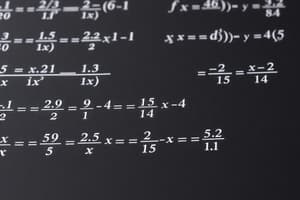Podcast
Questions and Answers
What property is used to prove that (-a) b = a (-b) = -ab?
What property is used to prove that (-a) b = a (-b) = -ab?
- Associative Property of Multiplication
- Distributive Property of Multiplication over Subtraction (correct)
- Closure Property of Multiplication
- Commutative Property of Multiplication
What is the result of multiplying a by (-b)?
What is the result of multiplying a by (-b)?
- a/b
- -a/b
- -ab (correct)
- ab
If a and b are real numbers, what can be concluded about the product (-a) (-b)?
If a and b are real numbers, what can be concluded about the product (-a) (-b)?
- It is equal to ab
- It is always positive
- It is equal to -ab (correct)
- It is always negative
Which of the following is an example of the closure property of multiplication?
Which of the following is an example of the closure property of multiplication?
If a and b are real numbers, what can be concluded about the expression a (-b)?
If a and b are real numbers, what can be concluded about the expression a (-b)?
Which of the following is an example of the associative property of multiplication?
Which of the following is an example of the associative property of multiplication?
What is the result of multiplying (-a) by b?
What is the result of multiplying (-a) by b?
If a, b, c, and d are real numbers, what can be concluded about the expression c (bd)?
If a, b, c, and d are real numbers, what can be concluded about the expression c (bd)?
Which of the following illustrates the closure property of multiplication?
Which of the following illustrates the closure property of multiplication?
What is the result of (4 % 5) % 8?
What is the result of (4 % 5) % 8?
Which property is used in the equation -3 < -2 ⇒ 0 < 1?
Which property is used in the equation -3 < -2 ⇒ 0 < 1?
Which of the following is a consequence of the multiplicative properties of inequality?
Which of the following is a consequence of the multiplicative properties of inequality?
What is the distributive property of multiplication over addition?
What is the distributive property of multiplication over addition?
Which of the following is an example of a set operation?
Which of the following is an example of a set operation?
What is the value of x in the equation x - x = 0?
What is the value of x in the equation x - x = 0?
What is the result of 1000 % 1?
What is the result of 1000 % 1?
Which of the following is a property of a field?
Which of the following is a property of a field?
What is the additive inverse of a number a?
What is the additive inverse of a number a?
Which of the following sets possesses all the properties of a field?
Which of the following sets possesses all the properties of a field?
What is the result of the set operation a ∪ (b ∩ c)?
What is the result of the set operation a ∪ (b ∩ c)?
What is the result of multiplying (a + b)c?
What is the result of multiplying (a + b)c?
Which of the following is a consequence of the order properties of inequality?
Which of the following is a consequence of the order properties of inequality?
Flashcards are hidden until you start studying
Study Notes
Quadratic Equations and Number Systems
Properties of Real Numbers
- Addition and multiplication of real numbers are commutative, associative, and distributive.
- Properties of inequality:
- If both sides of an inequality are multiplied by a positive number, the direction of the inequality does not change.
- If both sides of an inequality are multiplied by a negative number, the direction of the inequality is reversed.
Properties of Multiplication
- Distributivity of multiplication over addition:
a(b + c) = ab + acand(a + b)c = ac + bc - Properties of equality of numbers:
aand(-a)are additive inverses of each other.a(b - c) = ab - acand(x - y)z = xz - yz
Order Properties
- If
a > bandc > d, thenac > bd. - If
a < bandc < d, thenac < bd.
Properties of Inequality
- If both sides of an inequality are multiplied by a positive number, the direction of the inequality does not change.
- If both sides of an inequality are multiplied by a negative number, the direction of the inequality is reversed.
Examples and Applications
(-a)b = a(-b) = -ab(-a)(-b) = aba(b + c - d) = ab + ac - ad1000 % 1 = 10004.1 + (-4.1) = 0a - a = 0a(b - c) = ab - acand(x - y)z = xz - yz
Studying That Suits You
Use AI to generate personalized quizzes and flashcards to suit your learning preferences.




